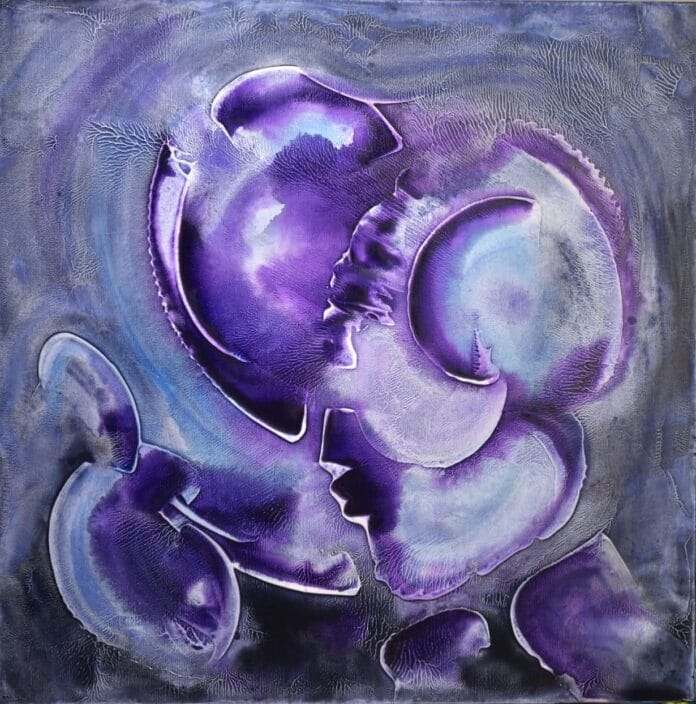Thierry Deliveyne, born in 1949 in Paris, is a testament to the idea that it’s never too late to embrace a passion. Although surrounded by the rich cultural energy of the French capital, his first love was not painting but architecture. After studying at the prestigious École nationale supérieure des Beaux-Arts (ENSBA) in Paris, Deliveyne’s early career path was shaped by structure, space, and precision. This architectural foundation would later inform his approach to composition and spatial balance.
In the years following his studies, Deliveyne explored abstract photography, a medium that allowed him to capture shapes, textures, and emotions beyond literal representation. However, when he tried to translate certain dreamlike visions into two-dimensional form, he discovered that photography alone could not fully contain his ideas. It was in the late 1990s that he found his true medium, abstract painting.
A Self-Taught Path and Original Techniques
Unlike many artists who follow a traditional academic route in fine arts, Deliveyne entered the world of painting without formal training in the medium. This apparent limitation became a strength. Unbound by convention, he developed his own unique techniques, allowing spontaneity and experimentation to lead the way.
His work is guided by intuition rather than rigid planning. The absence of academic constraints freed him to merge chance and control, structure and fluidity, resulting in compositions that feel both deliberate and organic. Over the years, his exploration has crystallized into three primary lines of research, each distinct in style yet united by a commitment to emotion, movement, and balance.
Intuitive Abstract Compositions – The Language of Gesture and Color
One of Deliveyne’s central artistic explorations is his highly colorful, intuitive abstract painting on canvas. Here, the process begins in silence, away from intellectual interference, as the artist seeks a direct connection to feeling. Using a palette knife, he creates white reliefs with raised textures that form the skeletal structure of the composition. These reliefs not only add a tactile dimension but also act as boundaries, channels, and partitions for the fluid color that follows.
Once the relief has dried, Deliveyne applies liquid pigments. This stage is where spirit and chance meet. The paint flows and spreads, sometimes settling into the contours created by the relief, sometimes spilling beyond, reconstructing balance and geometry. In these moments, hazard plays its part, allowing the unpredictable to harmonize with the artist’s guiding hand. The result is a vibrant dance between texture and translucency, form and movement.
Capillarity Painting – The Science of Fluid Art
In a second line of research, Deliveyne delves into the fascinating interplay between pigment, moisture, and paper in what he calls “capillarity painting.” This technique begins with multi-pigmented fluid color placed between two sheets. As the sheets press together, the pigments migrate by capillarity, the natural movement of liquid through a surface, creating unexpected structures and intricate patterns.
Here, chemistry and physics collaborate with artistic intuition. Deliveyne welcomes the surprises this method brings, understanding that the beauty lies in the balance between control and surrender. Each piece is a one-of-a-kind experiment in movement, texture, and form, as natural forces leave their own signature on the work.
Black and White Ink Works – Minimalist Elegance
While much of Deliveyne’s work celebrates color, his third avenue of exploration is a more refined, monochromatic practice using black and white ink. Even here, the intuitive gesture remains central. Without the distraction of color, the focus shifts to line, contrast, and spatial rhythm. These works reveal a stripped-down elegance, where the viewer’s attention is drawn to the raw energy of the brushstroke and the meditative balance of positive and negative space.
This minimalist approach also serves as a counterbalance to his more colorful creations, demonstrating his ability to communicate emotion and structure with the simplest of palettes.
The Role of Intuition and Silence
Across all his techniques, one theme remains constant: Deliveyne’s deep trust in intuitive creation. He speaks of “forgetting the mind” and “connecting with silence” as essential to his process. This meditative state allows him to bypass overthinking, giving space for instinct and emotion to guide the work. The resulting paintings are not mere visual arrangements but emotional landscapes, spaces where viewers can sense both spontaneity and harmony.
In many ways, his process mirrors jazz improvisation: a prepared foundation followed by an unplanned, responsive performance. The relief structures, pigment flows, and ink gestures become visual notes in a composition where freedom and structure coexist.
“Abstract painting is to figurative painting what music is to song”
A Dialogue Between Control and Chance
Deliveyne’s work invites viewers to consider the balance between human intention and natural unpredictability. The interplay of relief and fluid pigment, the migration of colors through capillarity, and the free sweep of ink lines all reflect the dynamic relationship between control and surrender. This is perhaps why his paintings feel alive; each one is a frozen moment in an ongoing conversation between the artist and his materials.
Conclusion – The Evolving Vision of Thierry Deliveyne
From his beginnings in architecture and abstract photography to his late embrace of painting, Thierry Deliveyne’s journey has been one of exploration and reinvention. His self-taught techniques, rooted in intuition and enriched by the unpredictability of natural processes, have resulted in a body of work that defies easy categorization.
Whether through colorful, textured canvases, delicate capillary paintings, or refined monochromatic ink works, Deliveyne continues to expand the boundaries of abstract art. His paintings are not just visual compositions; they are living records of movement, chance, and emotion, each inviting viewers into a world where structure meets spontaneity.


